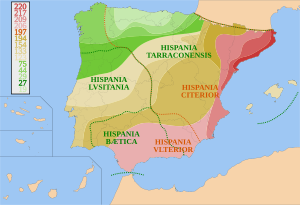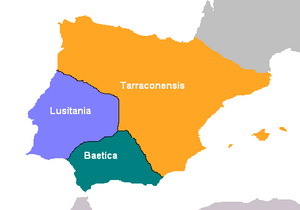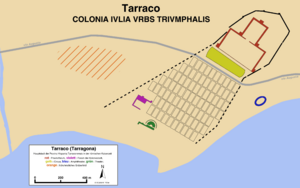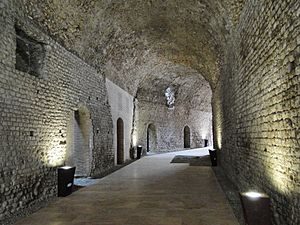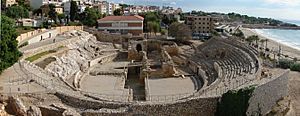Tarraco facts for kids
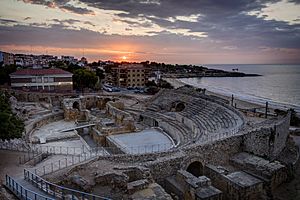
|
|
| Location | Tarragona, Catalonia, Spain |
|---|---|
| Region | Hispania |
| Coordinates | 41°6′59″N 1°15′19″E / 41.11639°N 1.25528°E |
| Type | Settlement |
| History | |
| Cultures | Iberian, Roman |
| Official name | Archaeological Ensemble of Tárraco |
| Type | Cultural |
| Criteria | ii, iii |
| Designated | 2000 (24th session) |
| Reference no. | 875rev |
| Region | Europe and North America |
Tarraco was the old name for the city now called Tarragona. It is located in Catalonia, Spain. This city was the very first Roman settlement on the Iberian Peninsula. Later, it became the main city of a big Roman province called Hispania Tarraconensis. This happened during the time of the Roman Empire.
In the year 2000, the ancient ruins of Tarraco were named a World Heritage Site by UNESCO. This means they are very important to human history.
Contents
History of Tarraco
Early Days and the Second Punic War
People called Iberians lived in this area from about 500 BC. They lived mostly in the Ebro Valley. They traded with the Greeks and Phoenicians who lived along the coast.
Tarraco is first mentioned when the Romans arrived in 218 BC. This was at the start of the Second Punic War. This war led to the Roman conquest of Hispania. The Romans took over a supply area for Hannibal's army near a city called Cissis. They also took Cissis itself. Soon after, the Romans were attacked "not far from Tarraco." Some think Cissis and Tarraco might have been the same city.
In 217 BC, more Roman soldiers arrived. Two Roman leaders, Publius and Gnaeus Cornelius Scipio, made Tarraco stronger. They built up its defenses and created a military port. The Roman city wall was likely built on top of older Iberian walls.
After the Scipio brothers died, Scipio Africanus used Tarraco as his winter base. This was between 211 and 210 BC. The people of Tarraco were very loyal to the Romans during the war. Fishermen from Tarraco even helped the Romans with their boats during a battle at Carthago Nova.
Tarraco in the Roman Republic
The Romans took over the Iberian Peninsula over 200 years. During this time, Tarraco stayed an important supply base. It was also a winter camp during wars against the Celtiberians. This meant many soldiers were always in the city.
In 197 BC, the conquered areas were split into two Roman provinces. These were Hispania Ulterior and Hispania Citerior. Tarraco became an important city in Hispania Citerior. Sometimes, the Roman governors lived there.
Tarraco was likely a "meeting place for Roman citizens" during this time. It had two civilian leaders. A Roman consul, Gaius Porcius Cato, chose Tarraco for his exile in 108 BC. This shows that Tarraco was a free city or an ally of Rome.
When Julius Caesar fought his enemies in 49 BC, Tarraco helped his army with food. After Caesar won a big battle, Tarraco likely became a Roman colony around 45 BC. Its full name became Colonia Iulia Urbs Triumphalis Tarraco. This name stayed throughout the Roman Empire.
The Age of Augustus
In 27 BC, Emperor Augustus changed how the Roman provinces were organized. Hispania Citerior became a much larger province called Hispania Tarraconensis. This new province was named after its capital, Tarraco. It included lands in central, northern, and northwestern Hispania.
Augustus himself came to Spain in the same year. He wanted to check on military campaigns. Because he was not well, he stayed in Tarraco. It is said that Augustus had an altar built in the city. A funny story says that the people of Tarraco told Augustus a palm tree had grown on his altar. He joked that it must mean the altar was not used very often!
Soon after Augustus arrived, an old road became the Via Augusta. A stone marker found in Tarragona shows this road was built between 12 and 6 BC. It connected Tarraco to cities like Barcino and Valentia.
Tarraco grew a lot under Augustus. A writer named Pomponius Mela described it as "the richest port on this coast." Tarraco even made its own coins. These coins showed images of the emperor and had the city's initials.
After Augustus died in 14 AD, he was made a god. In 15 AD, a temple was built in Tarraco to honor him. This temple was probably near the city's main public square.
Later Roman Empire
In 68 AD, Galba, who had lived in Tarraco for eight years, became emperor. Emperor Vespasian later helped improve the state's money problems. This allowed many people in Hispania to become Roman citizens. The Iberian Peninsula changed from tribal areas to areas organized around cities. This made it easier to collect taxes.
Many new buildings were constructed during this time. The Tarragona Amphitheatre, the temple area, and the Provincial forum were likely built then. Most statues in these places were put up between 70 and 180 AD.
Later, the city faced money problems in the late 2nd century AD. Fewer new statues were built. This was probably because of a lack of money. Also, there were fewer influential merchants in the city's government. More large landowners and public officials took their place. Emperor Severus rebuilt the amphitheater and nearby structures.
Tarraco in Late Antiquity
After Emperor Diocletian changed the Roman government, the peninsula was divided into six smaller provinces. Tarraco remained the capital, but of a much smaller province.
Around 260 AD, groups like the Franks and Alemanni invaded. This caused difficulties for about ten years. However, studies of the ruins show that the city itself was not destroyed. Damage was mostly seen in the harbor area and outside the city walls.
A "portico of Jupiter" was built between 286 and 293 AD. This might have been part of a large public building.
In 476 AD, the Visigoths took over Tarraco. This happened after the Roman defenses in other areas collapsed. There is no sign of destruction, so the city was likely taken peacefully. The Visigoths probably used the existing buildings. The ancient history of Tarraco ended when the Muslims arrived in 713 or 714 AD.
Archaeological Finds
The ancient Roman city of Tarraco is one of the biggest Roman sites still preserved in Spain. You can find writings on stones in Latin and even Phoenician throughout the city. Some of the huge, old walls near a building called Pilate's offices are thought to be from before the Romans. This building was a prison in the 1800s. People say it was once the palace of Emperor Augustus.
The amphitheater is near the sea. Large parts of it are still standing. It is 46 meters long. The Roman Aqueduct de les Ferreres, also called Pont del Diable (Devil's Bridge), crosses a valley. It is about 4 km from the city. It is 21 meters long. Its lower arches are almost 3 meters tall. The Roman tomb called Torre dels Escipions (Tower of the Scipios) is about 1.5 km northwest of the city.
Important Monuments
| Code | Name | Place | Coordinates |
|---|---|---|---|
| 875-001 | Roman walls | Tarragona | 41°07′12.4″N 1°15′32.6″E / 41.120111°N 1.259056°E |
| 875-002 | Imperial cult enclosure | Tarragona | 41°07′10.3″N 1°15′30.0″E / 41.119528°N 1.258333°E |
| 875-003 | Provincial forum | Tarragona | 41°07′05.0″N 1°15′21.0″E / 41.118056°N 1.255833°E |
| 875-004 | The Circus | Tarragona | 41°06′56.9″N 1°15′24.5″E / 41.115806°N 1.256806°E |
| 875-005 | Colonial forum | Tarragona | 41°06′52.5″N 1°14′56.6″E / 41.114583°N 1.249056°E |
| 875-006 | The Roman theatre | Tarragona | 41°06′48.6″N 1°14′52″E / 41.113500°N 1.24778°E |
| 875-007 | The Amphitheatre, the basilica and romanesque church | Tarragona | 41°06′53.0″N 1°15′33.5″E / 41.114722°N 1.259306°E |
| 875-008 | Early Christian Cemetery | Tarragona | 41°06′53.1″N 1°14′18.0″E / 41.114750°N 1.238333°E |
| 875-009 | Aqueduct | 4 km north of Tarragona | 41°08′47.6″N 1°14′36.6″E / 41.146556°N 1.243500°E |
| 875-010 | Torre dels Escipions | 5 km east of Tarragona | 41°07′52.7″N 1°18′59.0″E / 41.131306°N 1.316389°E |
| 875-011 | Quarry of El Mèdol | 9 km north of Tarragona | 41°08′12.7″N 1°20′22.4″E / 41.136861°N 1.339556°E |
| 875-012 | The Mausoleum of Centcelles | 4,6 km north-northwest of Tarragona | 41°09′07.6″N 1°13′49.7″E / 41.152111°N 1.230472°E |
| 875-013 | The villa dels Munts | 10 km east of Tarragona | 41°08′01.8″N 1°22′22.8″E / 41.133833°N 1.373000°E |
| 875-014 | Triumphal Arc de Berà | 20 km east of Tarragona | 41°10′22.9″N 1°28′07.3″E / 41.173028°N 1.468694°E |
UNESCO World Heritage Site Status
UNESCO added the ruins of ancient Roman Tarraco to its list of World Heritage Sites. This is because they meet two important rules:
Criterion ii. The Roman remains of Tarraco are very important. They show how Romans planned cities and designed urban areas. They were a model for other capital cities in the Roman world.
Criterion iii. Tarraco gives us a clear and special look into the history of the Mediterranean lands in ancient times.
See also
 In Spanish: Tarraco para niños
In Spanish: Tarraco para niños



